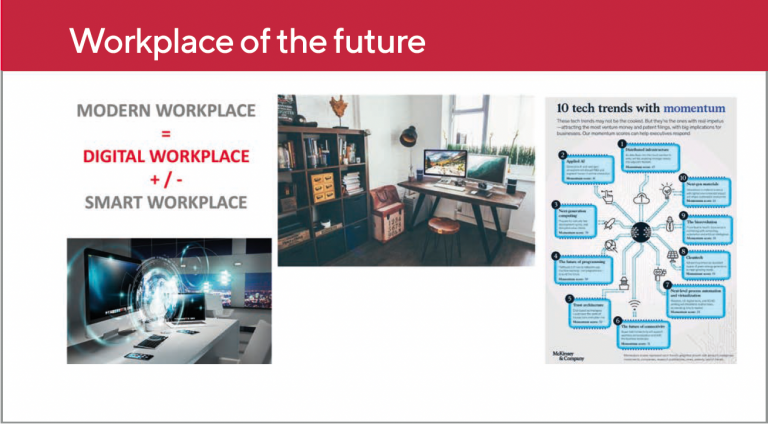In today’s corporate world, a story is playing out before our very eyes that has been witnessed many times before. As technologies converge, industries and private environments are being transformed, and the workplace is being reshaped.

However, the fundamental challenge remains that even the most successful companies today are operating on the basis of the old rules of management thinking that emerged during the first industrial revolution some 250 years ago. They are mechanistic. They tend towards and inevitably strive to achieve uniformity, bureaucracy, and control. If you ask managers about organization, most reflexively reach for a hierarchical diagram.
We are not just experiencing a fourth industrial revolution, but a true information revolution. A new set of technologies is enabling full automation of routine tasks, low transaction costs and networking that facilitates self-organizing complexity at an unprecedented speed.
We see four macro trends that override almost all the old rules of management:
- More connection. The global interconnectedness of people is permanently changing not only the speed of disruption but also the principles for breakthrough innovations. Information moving freely drives change instantly, bypassing – or even challenging – existing hierarchies and formalized channels of change. The resulting “chaos” leads to unpredictability, both negative and positive, that companies must try to embrace. For most companies, the clear boundaries of who “belongs” to the company and who does not are blurring, and what looked like clear boundaries are now becoming concentric circles where the types of people and organizations working together to create value are very different and system participants exist along a whole spectrum of stakeholders.
- Unprecedented automation. Technology on a large scale and at a low cost (from cameras mounted everywhere to ubiquitous interactions between machines) is forever changing the way management creates value and improves efficiency. We no longer need employees to behave like machines.
- Lower transaction costs. The free-market mechanism, the main reason why profit-oriented businesses have thrived over the last 200 years, is becoming largely irrelevant. More and more people are self-organizing in a gig economy.
- Demographic shifts and mixed societies. Generation Z (and beyond) shows a behaviour far removed from previous generations of workers; their demands are fundamentally different in character. Companies that do not respond accordingly will not survive. The strong involvement of cross-functional and cross-national teams is also an even greater requirement.
These trends are not new – but they are now approaching a tipping point where organization as a topic is top of the agenda for CEOs and management boards. Enforced breakthroughs during the COVID 19 pandemic are accelerating some of these trends: in recent months, we have seen the extraordinary forced movement of labour into remote office environments and into areas of highest value (e.g. warehousing and delivery services hiring hundreds of thousands of workers), increased agility of internal teams, and the next stage of diffusion between “enterprise” and “gig” economies.
Digital organization = a paradigm shift in leadership
When leaders let go of old paradigms and embrace new ones – such as digitalization – new opportunities open up in our increasingly interconnected world where the sources of value creation are constantly changing. As these changes are occurring constantly, successful decision-makers must adopt an open and digital systems view instead of a mechanistic view of organizations. Not only will leaders begin to better understand the current landscape, but they will also be empowered to make decisions about what to do to expand value creation opportunities.
Digital organization = understanding one’s own analogue and digital DNA
When it comes to digital enablement, the time for incremental improvements is clearly over. It’s time to do something big – something that goes beyond moving systems to the cloud or introducing tools that allow employees to work when, where, and how they want.
Digital DNA characteristics include a company’s ability to collaborate consciously, innovate continuously, ‘democratize’ information and work with changing team structures – to name just a few. Understanding and building your organization’s digital DNA is essential to becoming a truly digital company – and it is also just one of several factors that can help you accelerate digital transformation in organizations.

Since 2020, many have hailed the digital workplace as a solution for everything from business continuity to employee engagement and retention. Some companies are betting on the future of virtual work and new ways of working. Others have come to terms with the fact that a mix of face-to-face and remote working is likely to be here in the long run, leading to the need to consider making changes to the physical and digital workplace, investing in new skills, and introducing new working norms. And for those employees who work away from the office, companies are investing in solutions that enable work via digital capabilities and automation. Whether they work on-site or remotely, workers in all workspaces benefit from seamless digital workplace solutions that facilitate the future of primarily knowledge-based work. #Macrotend More connection (see above).
This also means that for a significant part of the knowledge-based workforce, their digital experience is their workforce experience. Moreover, digital tools are now used to connect the entire workforce. But in a hyper-connected world where employees influence market performance as much as customers, many companies have not yet addressed how their employees can best perform their jobs in the digital environment made available to them – and how this affects their future prospects.
While most employers today have a variety of digital solutions at their disposal, many of these solutions possess duplicate functions and the ecosystem is becoming increasingly difficult for employees to navigate. Even more worryingly, there is little evidence that these solutions increase employee productivity. Instead, employees are confronted with an incoherent work environment where priorities often diverge.
However, when a company is constantly on the move, aligning its culture, its organizational structure, and its assets with their digital business strategy is no easy feat.
Digital organization = sustainable data management

Data plays a prominent role in the digital organization of work. In contrast to paper, digital data is much more volatile, much more vulnerable, and requires other forms of protection. Questions such as: Who do I trust with my data – internally and externally? How is the data organized? How should access to the data be organized? How much data is generated in a month, for example, and where? Does the data have to be stored for a long time? The answers to these questions – which also played a role before digital organization – influence the solutions and tools for secure and sovereign data management in companies.
CEOs and board members must consider issues such as confidentiality, whistleblowing and compliance, cybersecurity, analysis, and the interpretation of data. There is still a lot to be done regarding these aspects in order to be able to build data-driven business intelligence on them as a result.
Intelligent data management can contribute positively to the sustainability goals of companies and organizations right from the start. Sustainability in the sense of environmental compatibility is achieved, for example, by reducing the amount of data and thus also the amount of storage space required and maintenance, while the correctly performed backup and storage of data contributes to the sustainable success of the company as a whole.
In terms of data volumes, we know that there is much more data in digital form than exists in physical form. People tend to hoard and since it has become relatively cheap to keep and store files easily, the amount of data we have to deal with has multiplied. However, organizations need to have an overview of their data and permanently maintain it, otherwise they become incapable of acting in a worst-case scenario. To avoid this from the outset, it is important to regularly review the data and reduce it in a sensible way. For example, during the next data protection audit.
Digital work organization – possible by applying three key principles
Digitization is seen as a centerpiece in business.
This requires that companies and organizations redefine their business and make digitalization more than a matter of mere polemics. Digital processes, digital engagement, and a digital strategy permeate every aspect of business. Realizing that there is much more to digitalization than new technologies and social media is a top priority. Companies that have set out on this journey know that their digital success ultimately depends on how they are organized, how they work, and how they behave.
Developing a supportive environment and culture.
Digital companies are purposefully cultivating their culture, actively developing talent, and organizing themselves to reach digital maturity. This includes a recruitment strategy that enables the future of work and matches employees with cognitive technologies to reshape the way work gets done. They are creating work experiences for their employees – analogously and as passionately as they are for their customers – giving them digital tools that help them manage their time effectively, enable secure communication, and collaborate purposefully across countries and time zones. They develop staff skills in a continuous learning environment, reinforcing digital concepts at every opportunity and encouraging staff to think digitally.
They take action instead of just propagating a vision.
They build up engagement and digitally literate employees who can actively help embed digital capabilities into the fabric of their business and work across departments and functions to ensure that smart ideas and tools are not confined to a particular corner of their business or organization. They are careful not to simply bring more technology into the business. Instead, they think strategically and proactively, focusing on business growth in all its forms and providing the right resources to fund its development.
*Figure 3: pexels – cottenbro

Maria Bauer
COO and authorized signatory of Cloudical
maria.bauer@cloudical.io
